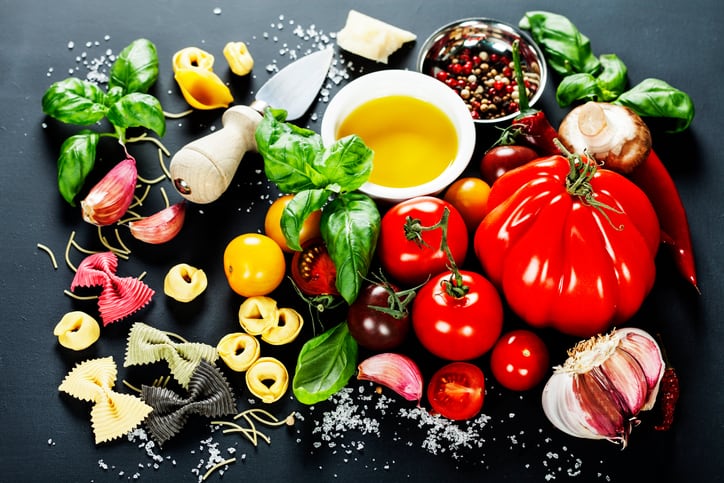With the rise of nutrition-related diseases and obesity across the EU, health campaigners and the food industry (keen for the certainty of standardisation) have long been pressing Brussels to introduce a unified labelling system across the bloc. The European Commission is expected to make a recommendation of its preferred system before the summer.
While some countries have developed their own schemes, such as the traffic light system in the UK and the keyhole symbol in Sweden, the French Nutri-Score system is gaining support as the system the EU will choose.
Nutri-Score classifies food and beverages according to their nutritional profile by using a colour-coded system with a scale ranging from A (healthier choices) to E (less healthy choices). The scheme became France's official food label in 2017. It is voluntary, but it is the only label to have official government recognition. Governments in Germany, the Netherlands, Switzerland, Spain and Belgium have also opted for Nutri-Score as their voluntary labelling scheme of choice. Many major retailers and food producers in Europe such as Nestlé, Kellogg and Danone have also voluntarily chosen to adopt Nutri-Score.
However, Nutri-Score has its critics, chief among them Italy, which complains the system unfairly discriminates against its famous food delicacies such as olive oil, Parma ham and Parmigiano cheese. Italy fears these items, under Nutri-Score, would receive red-to-orange warning signs on labels owing to their fat and salt content.
‘Now we have one more tool to protect Made in Italy’
The Italian Ministry of Economic Development, under pressure from trade unions and politicians of all stripes, has now officially presented an alternative plan for a new nutrition-labelling scheme – NutrInform -- to the European Commission. This system, similar to the UK’s traffic lights, uses columns or batteries to display the percentage of energy, fats, saturated fats, sugars and salt contained in the portion of product in relation to reference daily intake.
“[NutrInform] is our alternative to Nutri-Score, but it is far better. It is not penalising, it does not give good or bad grades,” Italian Agriculture Minister Teresa Bellanova said in a statement.
The announcement accused Nutri-Score of being “opposed to the principles of the Mediterranean diet which is based on a balanced consumption of all foods.”
It continued: “With the Italian system of nutritional labelling, the Government aims to provide the consumer with clear and concise information on the presence of certain nutrients in foods, useful for placing them within a varied and balanced diet, such as the Mediterranean one, and to enhance and protect the entire Italian agri-food chain.”
Ivano Vacondio, president of Italy’s food industry representative body Federalimentare, said Nutri-Score “could undermine Italian food excellence” and “is based on simplistic, discriminatory and penalising principles”. He welcomed NutrInform as an approach “based on the principles of the Mediterranean diet, the best in the world, and we are happy that it was notified to the European Commission just yesterday. Now we have one more tool to protect Made in Italy.”
NutrInform is clumsy and misleading, say campaigners
However, consumer campaigners claim the Italian alternative to Nutri-Score is “counter-intuitive” and “confusing”. Italian consumer group Altroconsumo said it favours Nutri-Score. “A nutritional label should be based on uniform reference amounts (such as per 100g/100ml) and should use a colour-coding to help consumers to compare the nutritional value of foods across a range of products. This is the Nutri-Score,” a spokesperson told FoodNavigator.
According to Altroconsumo, the NuntrInform battery system is too complicated for consumers. “It doesn’t use a colour-coding and it gives information per portion, not allowing consumers to compare products effectively. In addition, to suppose consumers can identify a risk/alert ‘of an excessive charge (intake)’ on the battery symbol makes no logical sense: consumers normally associate the low level charge signal as a need to fully recharge the battery (not enough intake/charge) which should not be exactly the case.”
Emma Calvert, Food Policy Officer at the European Consumer Organisation (BEUC), the umbrella organisation of which Altroconsumo is a member, went on to accuse the battery scheme of ‘blatantly misleading consumers’. “This scheme as a clumsy attempt to simplify nutrition information,” she told FoodNavigator.
“The fact that the battery-style columns just replicate the nutrition table at the back doesn’t make it easier for consumers to decipher the figures. These batteries are monochrome, hence lacking the colour-coded aspect which has been proven to help consumers understand at a glance the nutritional qualities of their food.
“Also, the batteries are based on portion sizes, which are self-defined by manufacturers and rarely represent the actual amount one would eat. It should be based on 100g/ml to make comparisons between similar products easier.
“Last but not least, everyone tends to believe that the more charged a battery is, the better. In fact, here, consumers should not strive to reach 100% of the battery for a given nutrient; it’s the opposite. By contrast, the Nutri-Score does tick all the boxes of an efficient front-of-pack label. That’s why we are calling for its mandatory use in the EU.”
Calvert insisted that Nutri-Score does not discriminate against the Mediterranean diet. “It’s the opposite. The traditional Mediterranean diet is high in fruit, nuts, vegetable, legumes and cereals, low in red and processed meats and dairy products, and has olive oil as a major source of fat. This is all in line with Nutri-Score, which takes into account nutrients to limit (calories, saturated fat, sugars and salt) and those elements to favour (fibre, proteins, nuts, fruit and vegetables).”
That’s in contrast to Nutri-Score opponents who complain the algorithms that calculate Nutri-Score create scores are simplistic, and that the system discriminates against ostensibly ‘healthy foods’ with a high saturated fat content such as canned fish and olive oil. Some even suggest the system is susceptible to abuse from food companies who may seek to mask potentially unhealthy ingredients in products.
According to Frederik Leroy, professor of food science and biotechnology, at Vrije University in Brussels: “Producers of ultra-processed foods are able to engineer a way around the criteria because they can add a bit of fibre so they are able to tweak the score, whereas producers of things like smoked salmon, cheese and ham can’t do that.”
Calvert insisted that Nutri-Score allows consumers to distinguish between ‘good’ and ‘bad fats. “Olive oil comes across as a source of good fat (‘C’) compared to butter (’E’) or saturates-rich vegetable oils such as palm oil (‘E’),” she said.
‘A half-filled battery does seem something that needs filling’
Luca Bucchini, managing director of Rome-based food sector regulatory consultancy Hylobates Consulting, agreed that Italy’s battery system would not provide clearer nutritional information to consumers. “A half-filled battery does seem something that needs filling whereas for some nutrients the less the better,” he said. The system would therefore be unlikely to help tackle Italy’s ‘acute obesity problem’.
Italy’s uncompromising approach will leave it isolated
Bucchini said that Italy's grievances with Nutri-Score are valid in some cases. "Traditional products see reduced sales when they have traffic lights or NutriScore because they are perceived as 'bad', while moderate consumption is acceptable and may play an important role in the diet. [NutriScoere] ignores the fact that consumers do not know that they do need fats and thus olive oil."
But he added that Italy's total opposition to Nutri-Score or similar schemes leaves it ‘increasingly isolated within the EU’.
“Contrast this with the pragmatic approach of the Dutch who have accepted Nutri-Score but have said it will require changes. Italy's stated aim to protect traditional products is probably not well served by the batteries. They do not even have support in Italy among public health or consumer groups.”




